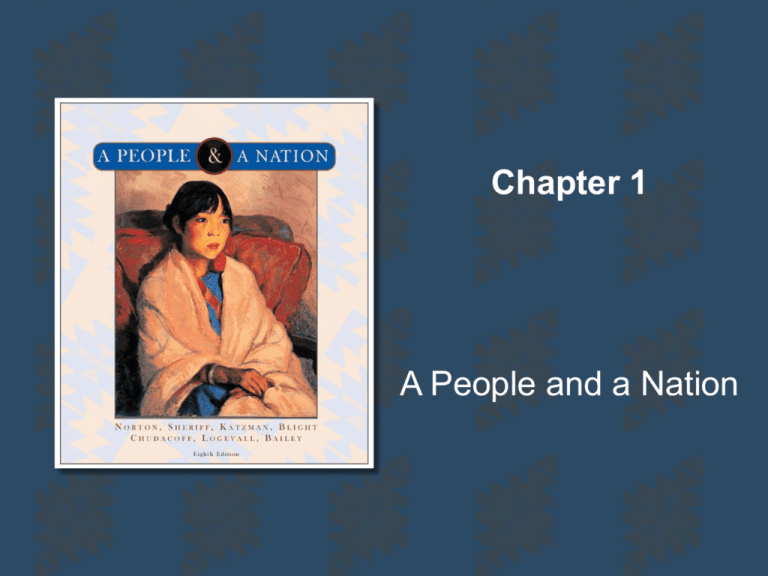
Chapter 1
A People and a Nation
What caused the extinction of most of
the large American mammals over
10,000 years ago?
1.
2.
3.
4.
Overhunting by the growing human population.
Climactic change.
A wide-spread epidemic.
Scholars cannot agree on whether overhunting or the
change in climate caused the mass extinction.
Copyright © Houghton Mifflin Company. All rights reserved.
1|2
What caused the extinction of most of
the large American mammals over
10,000 years ago?
4. Scholars cannot agree on whether overhunting or the
change in climate caused the mass extinction.
Hint: See p. 5.
Copyright © Houghton Mifflin Company. All rights reserved.
1|3
In North American before 1492,
agricultural societies:
1.
2.
3.
4.
Were organized matrillineally.
Always defined agricultural labor as men’s work.
Had low birth rates.
Relied on women as religious leaders.
Copyright © Houghton Mifflin Company. All rights reserved.
1|4
In North American before 1492,
agricultural societies:
1. Were organized matrillineally.
Hint: While agricultural societies differed in regards to
their concepts of men’s and women’s roles, they were
consistently arranged matrillineally; that is, clans were
linked by the female members of the families. See p.
10.
Copyright © Houghton Mifflin Company. All rights reserved.
1|5
Fifteenth-century Upper Guinea, the
northern area of West Africa, was
heavily influenced by:
1.
2.
3.
4.
Spanish Catholicism
Islamic Mediterranean culture.
Its relationship to the interior areas of Africa.
The slave trade.
Copyright © Houghton Mifflin Company. All rights reserved.
1|6
Fifteenth-century Upper Guinea, the
northern area of West Africa, was
heavily influenced by:
2. Islamic Mediterranean culture.
Hint: Trade encouraged contact between the peoples of
Africa and the Mediterranean area. The Islamic faith
spread along these trade routes. See p. 12.
Copyright © Houghton Mifflin Company. All rights reserved.
1|7
The Hundred Years’ War (1337-1453)
between England and France was
caused by:
1. A struggle for control over the northern coast of
modern-day France.
2. An English claim to the French throne.
3. Religious differences.
4. Disagreement over control of important trading routes.
Copyright © Houghton Mifflin Company. All rights reserved.
1|8
The Hundred Years’ War (1337-1453)
between England and France was
caused by:
2. An English claim to the French throne.
Hint: The English monarchy claimed the French throne.
Because of the war, traders from the south were forced
to develop maritime routes to reach the northern areas
of Europe. See p. 15.
Copyright © Houghton Mifflin Company. All rights reserved.
1|9
The Portuguese used slaves on the
island of Madeira in order to cultivate:
1.
2.
3.
4.
Tobacco
Rice
Sugar
Wine
Copyright © Houghton Mifflin Company. All rights reserved.
1 | 10
The Portuguese used slaves on the
island of Madeira in order to cultivate:
3. Sugar
Hint: Since the cultivation of sugar requires an immense
amount of hard physical labor, the Portuguese used
slaves, who could not quit, in order to produce this
incredibly profitable crop. See p. 16.
Copyright © Houghton Mifflin Company. All rights reserved.
1 | 11
Around the year 1001, Norse voyagers
settled in:
1.
2.
3.
4.
Newfoundland
Greenland
Iceland
Nova Scotia
Copyright © Houghton Mifflin Company. All rights reserved.
1 | 12
Around the year 1001, Norse voyagers
settled in:
1. Newfoundland
Hint: The Norsemen and women had lived in Greenland
and Iceland previous to this time. Hint: See p. 21.
Copyright © Houghton Mifflin Company. All rights reserved.
1 | 13
John Cabot, a Genovese master
mariner, sailed to North America in
1497 for which European monarch?
1. Queen Isabella of Spain
2. The Holy Roman Emperor
3. He did not sail for a monarch; Cabot was an
independent merchant.
4. Henry VII of England.
Copyright © Houghton Mifflin Company. All rights reserved.
1 | 14
John Cabot, a Genovese master
mariner, sailed to North America in
1497 for which European monarch?
4. Henry VII of England.
Hint: Like Columbus’ journey, Cabot’s excursion helped
establish permanent trading routes between Europe
and the Western Hemisphere. See p. 21-22.
Copyright © Houghton Mifflin Company. All rights reserved.
1 | 15
Who was Malinche?
1. A female slave given to Cortés upon his arrival in
Mayan territory.
2. Cortés’ translator.
3. Mother of Cortés’ son.
4. All of the above.
Copyright © Houghton Mifflin Company. All rights reserved.
1 | 16
Who was Malinche?
4. All of the above.
Hint: See p. 22.
Copyright © Houghton Mifflin Company. All rights reserved.
1 | 17
North American Indians became
focused almost wholly on hunting
buffalo after 1493 because:
1. Many of the other animals they had hunted previously
disappeared due to overhunting.
2. They acquired horses from Europeans.
3. They were pushed to lands where buffalo were more
available.
4. They needed the buffalo skins for themselves and to
trade.
Copyright © Houghton Mifflin Company. All rights reserved.
1 | 18
North American Indians became
focused almost wholly on hunting
buffalo after 1493 because:
2. They acquired horses from Europeans.
Hint: Horses enabled the Plains Indians to hunt buffalo
more efficiently and they gradually reduced their
reliance on other animals, as well as reducing their
gathering and agricultural patterns. See p. 25-26.
Copyright © Houghton Mifflin Company. All rights reserved.
1 | 19
English leaders of the sixteenth
century were inspired to plant
American colonies because:
1. They were facing growing competition with Spain for
dominance in trade.
2. They needed a place for religious dissenters to live.
3. They wanted to learn more about the trade items
available to them in America.
4. They needed seaports to support their global trade
networks.
Copyright © Houghton Mifflin Company. All rights reserved.
1 | 20
English leaders of the sixteenth
century were inspired to plant
American colonies because:
1. They were facing growing competition with Spain for
dominance in trade.
Hint: English colonies in America gave the English better
access to trade goods and also kept the Spanish from
dominating in America. See p. 28.
Copyright © Houghton Mifflin Company. All rights reserved.
1 | 21


